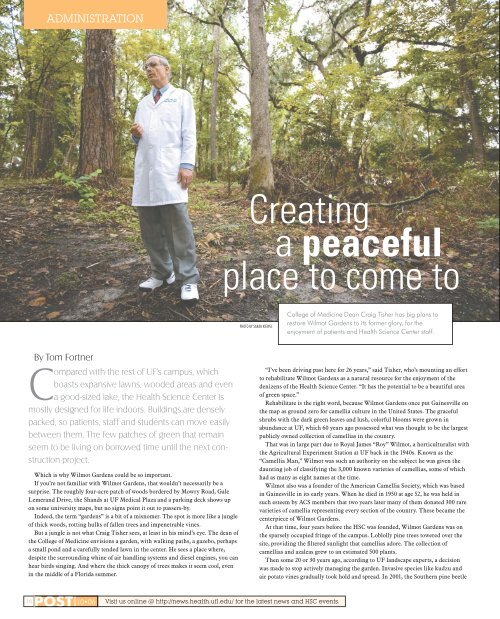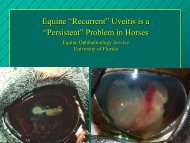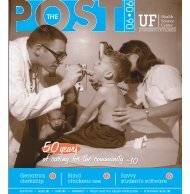Through the ceiling Through the ceiling - UF Health Podcasts
Through the ceiling Through the ceiling - UF Health Podcasts
Through the ceiling Through the ceiling - UF Health Podcasts
You also want an ePaper? Increase the reach of your titles
YUMPU automatically turns print PDFs into web optimized ePapers that Google loves.
ADMINISTRATION<br />
Creating<br />
a peaceful<br />
place to come to<br />
PHOTO BY SARAH KIEWEL<br />
College of Medicine Dean Craig Tisher has big plans to<br />
restore Wilmot Gardens to its former glory, for <strong>the</strong><br />
enjoyment of patients and <strong>Health</strong> Science Center staff.<br />
By Tom Fortner<br />
Compared with <strong>the</strong> rest of <strong>UF</strong>’s campus, which<br />
boasts expansive lawns, wooded areas and even<br />
a good-sized lake, <strong>the</strong> <strong>Health</strong> Science Center is<br />
mostly designed for life indoors. Buildings are densely<br />
packed, so patients, staff and students can move easily<br />
between <strong>the</strong>m. The few patches of green that remain<br />
seem to be living on borrowed time until <strong>the</strong> next construction<br />
project.<br />
Which is why Wilmot Gardens could be so important.<br />
If you’re not familiar with Wilmot Gardens, that wouldn’t necessarily be a<br />
surprise. The roughly four-acre patch of woods bordered by Mowry Road, Gale<br />
Lemerand Drive, <strong>the</strong> Shands at <strong>UF</strong> Medical Plaza and a parking deck shows up<br />
on some university maps, but no signs point it out to passers-by.<br />
Indeed, <strong>the</strong> term “gardens” is a bit of a misnomer. The spot is more like a jungle<br />
of thick woods, rotting hulks of fallen trees and impenetrable vines.<br />
But a jungle is not what Craig Tisher sees, at least in his mind’s eye. The dean of<br />
<strong>the</strong> College of Medicine envisions a garden, with walking paths, a gazebo, perhaps<br />
a small pond and a carefully tended lawn in <strong>the</strong> center. He sees a place where,<br />
despite <strong>the</strong> surrounding whine of air handling systems and diesel engines, you can<br />
hear birds singing. And where <strong>the</strong> thick canopy of trees makes it seem cool, even<br />
in <strong>the</strong> middle of a Florida summer.<br />
“I’ve been driving past here for 26 years,” said Tisher, who’s mounting an effort<br />
to rehabilitate Wilmot Gardens as a natural resource for <strong>the</strong> enjoyment of <strong>the</strong><br />
denizens of <strong>the</strong> <strong>Health</strong> Science Center. “It has <strong>the</strong> potential to be a beautiful area<br />
of green space.”<br />
Rehabilitate is <strong>the</strong> right word, because Wilmot Gardens once put Gainesville on<br />
<strong>the</strong> map as ground zero for camellia culture in <strong>the</strong> United States. The graceful<br />
shrubs with <strong>the</strong> dark green leaves and lush, colorful blooms were grown in<br />
abundance at <strong>UF</strong>, which 60 years ago possessed what was thought to be <strong>the</strong> largest<br />
publicly owned collection of camellias in <strong>the</strong> country.<br />
That was in large part due to Royal James “Roy” Wilmot, a horticulturalist with<br />
<strong>the</strong> Agricultural Experiment Station at <strong>UF</strong> back in <strong>the</strong> 1940s. Known as <strong>the</strong><br />
“Camellia Man,” Wilmot was such an authority on <strong>the</strong> subject he was given <strong>the</strong><br />
daunting job of classifying <strong>the</strong> 3,000 known varieties of camellias, some of which<br />
had as many as eight names at <strong>the</strong> time.<br />
Wilmot also was a founder of <strong>the</strong> American Camellia Society, which was based<br />
in Gainesville in its early years. When he died in 1950 at age 52, he was held in<br />
such esteem by ACS members that two years later many of <strong>the</strong>m donated 300 rare<br />
varieties of camellia representing every section of <strong>the</strong> country. These became <strong>the</strong><br />
centerpiece of Wilmot Gardens.<br />
At that time, four years before <strong>the</strong> HSC was founded, Wilmot Gardens was on<br />
<strong>the</strong> sparsely occupied fringe of <strong>the</strong> campus. Loblolly pine trees towered over <strong>the</strong><br />
site, providing <strong>the</strong> filtered sunlight that camellias adore. The collection of<br />
camellias and azaleas grew to an estimated 500 plants.<br />
Then some 20 or 30 years ago, according to <strong>UF</strong> landscape experts, a decision<br />
was made to stop actively managing <strong>the</strong> garden. Invasive species like kudzu and<br />
air potato vines gradually took hold and spread. In 2001, <strong>the</strong> Sou<strong>the</strong>rn pine beetle<br />
16<br />
POST 10•06 Visit us online @ http://news.health.ufl.edu/ for <strong>the</strong> latest news and HSC events.

















